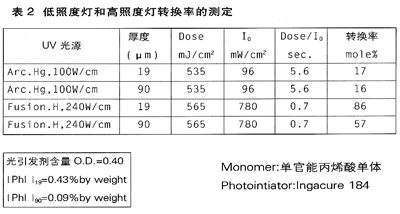UV curing device performance and photopolymerization issues
The requirements for the UV inkjet ink lamp device are:
1 Compact device design.
2 can be set up in the office.
3 Can be used as a copier application.
4 Do not choose substrates for media.
5 Can be imaged on any substrate.
6 Stable images can be obtained without skillful techniques.
7 The user's maintenance management of the equipment is very convenient.
In order to meet the above-mentioned ideal design requirements, the design of the UV lamp device is described as follows.
â— Miniaturized UV lamps installed on small-format inkjet printers must be designed for volume-free construction and easy to handle. At the same time, accessories such as lamps and cooling fans should be small, with small air volume and ink from The print head does not affect the ejection.
â— High-illuminance output and spectral matching In order to obtain a high-quality output image, the high-illuminance output from the UV lamp is required to match the spectral band required for curing.
1 Curing speed The ink with low viscosity (about 5-20 mP·s) can be realized without using dilute solvent, otherwise no ink can be sprayed from the print head. With this low-viscosity ink, in order to pursue high-quality images, the photopolymerization must be completed immediately after the ink falls on the substrate, otherwise the shape of the falling dots changes to deteriorate the image quality. The UV ink should maintain a large surface tension and try to keep the falling ink shape for a long time. It is difficult to maintain a certain surface tension between various substrates and inks, but it is important that the curing speed of the ink should be increased according to the UV lamp.

Table 2 shows the C=C conversion data of acrylate monomers measured using a Raman spectrometer. The test was performed using UV lamps of high and low illumination, respectively, and measured at the same cumulative light amount. In the case of high-illuminance lamps, a conversion rate of 86% can be obtained with an irradiation time of 1 s or less for an ink film of about 20 μm thick. In contrast, in the case of a low-illuminance lamp, irradiation time takes 56 s, but only 17% conversion is obtained. rate. This proves that high-illuminance output lamps are more advantageous for increasing the curing speed.
2 Curing in the depth direction
For ink-absorbent materials such as paper substrates, the ink that penetrates the interior of the substrate must also be UV curable. Not only does the surface of the ink cure at high speed, but it also cures sufficiently at depth, so the absorbance of the ink cannot be raised too high. Because if the absorbance is raised too high, the difference in absorbance between the upper portion and the lower portion of the ink film becomes large, so that the curing of the lower portion is insufficient. This can be explained on the basis of Lambert's law of one-earth. The change in the absorbance of the cured ink film in FIG. 3 (see the next page) is that, at a lower portion of the ink film (Bottoml%), if the absorbance exceeds a certain value (0.43), the amount of light absorption decreases; and the upper portion of the ink film (Topl The absorbance of %) increases in proportion to the absorbance.

From the results of FIG. 4 also the advantage of high illumination UV irradiation can be found.


Stainless steel Apple Corer removes pesky cores in seconds. It's great for apples, pears and other hard fruits. Sharp blade slices closely to cores, which helps to reduce the amount of fruit that goes to waste and leaves you with more to enjoy. It`s great for coring fruit to enjoy as a healthy snack. Or for quickly preparing lots of fruit to make pie fillings, sauces or jams. Like all Kitchen Craft Professional tools, it`s designed to be sturdy, simple and comfortable to use.
Apple Corer
Apple Corer,Home use Apple Corer,Stainless Steel Apple Slicer,Plastic Handle Fruit Corer
Yangjiang Superwins Trade Co., Ltd. , http://www.superwins-kitchenware.com